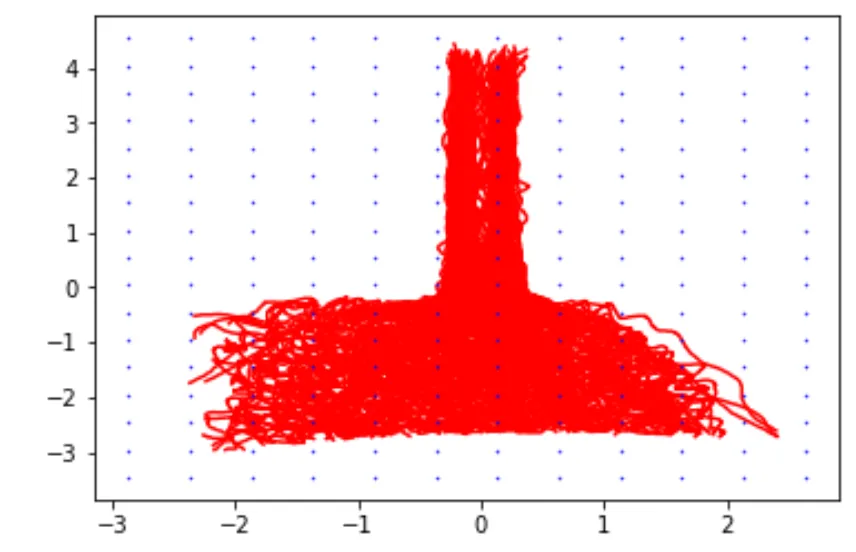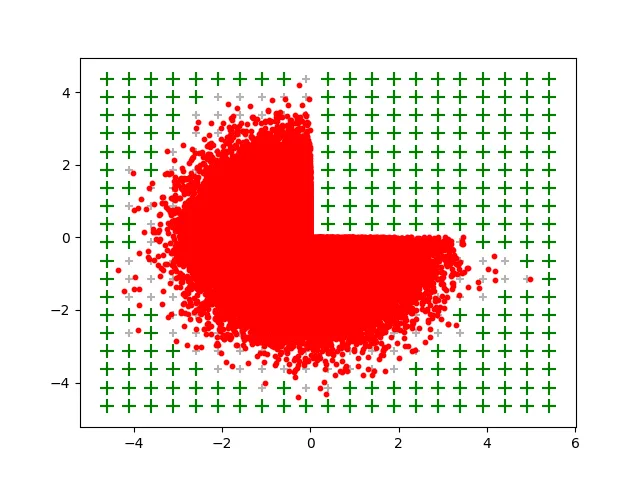你只需要选择一个你知道在外壳上的点(我们可以选择最上面的最左边的点),并假设你是从上方到达的(因为我们知道它上面没有点)。
现在,当下一个点不在你的列表中时:
尝试从你来的方向逆时针移动。
代码看起来像这样:
matrix = [[0, 0, 0, 0, 0, 0, 0, 0, 0, 0, 0, 0, 0, 0, 0, 0, 0],
[0, 0, 0, 0, 0, 0, 1, 1, 1, 0, 0, 0, 0, 0, 0, 0, 0],
[0, 0, 0, 0, 0, 0, 1, 1, 1, 0, 0, 0, 0, 0, 0, 0, 0],
[0, 0, 0, 0, 0, 0, 1, 1, 1, 0, 0, 0, 0, 0, 0, 0, 0],
[0, 0, 0, 0, 0, 0, 1, 1, 1, 0, 0, 0, 0, 0, 0, 0, 0],
[0, 0, 0, 0, 0, 0, 1, 1, 1, 0, 0, 0, 0, 0, 0, 0, 0],
[0, 0, 0, 0, 0, 1, 1, 1, 1, 0, 0, 0, 0, 0, 0, 0, 0],
[0, 0, 0, 0, 1, 1, 1, 1, 1, 1, 1, 1, 1, 0, 0, 0, 0],
[0, 1, 1, 1, 1, 1, 1, 1, 1, 1, 1, 1, 1, 0, 0, 0, 0],
[0, 0, 0, 1, 1, 1, 1, 1, 1, 1, 1, 1, 0, 0, 0, 0, 0],
[0, 0, 0, 0, 1, 1, 1, 0, 0, 0, 0, 0, 0, 0, 0, 0, 0],
[0, 0, 0, 0, 0, 0, 0, 0, 0, 0, 0, 0, 0, 0, 0, 0, 0]]
first_point = None
for i in range(len(matrix)):
if first_point:
break
for j in range(len(matrix[0])):
if matrix[i][j]:
first_point = [i, j]
break
next_point = first_point
prev_direction = 'up'
next_direction_dict = {'up': 'left', 'left': 'down', 'down': 'right', 'right': 'up'}
opposite_direction = {'up': 'down', 'left': 'right', 'down': 'up', 'right': 'left'}
hull_points = []
def go_direction(point, direction):
i = point[0]
j = point[1]
if direction == 'right':
j += 1
elif direction == 'up':
i -= 1
elif direction == 'left':
j -= 1
elif direction == 'down':
i += 1
else:
raise ValueError
return [i, j]
def find_next_point(matrix, point, prev_direction):
next_direction = next_direction_dict[prev_direction]
next_point = go_direction(point, next_direction)
prev_direction = next_direction
while not matrix[next_point[0]][next_point[1]]:
next_direction = next_direction_dict[prev_direction]
next_point = go_direction(point, next_direction)
prev_direction = next_direction
from_direction = opposite_direction[prev_direction]
return next_point, from_direction
next_point, prev_direction = find_next_point(matrix, next_point, prev_direction)
while next_point != first_point:
if next_point not in hull_points:
hull_points.append(next_point)
next_point, prev_direction = find_next_point(matrix, next_point, prev_direction)
编辑:现在还可以处理单点“触手”,通过迭代直到返回第一个点。



df_traj中给出的?你大约有多少个点?“很多”? - user202729